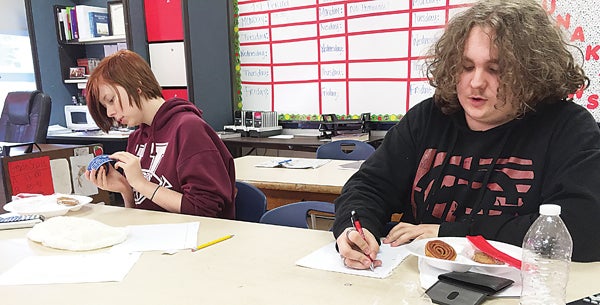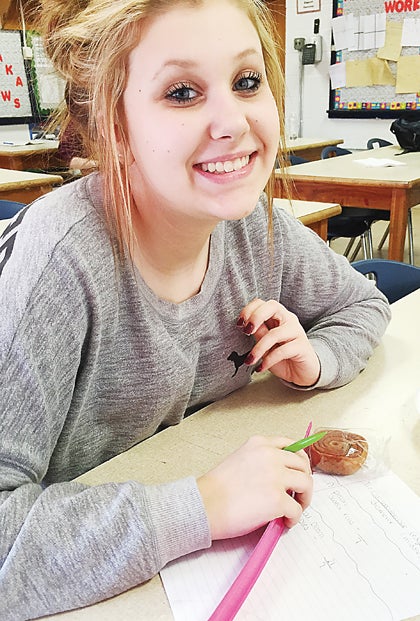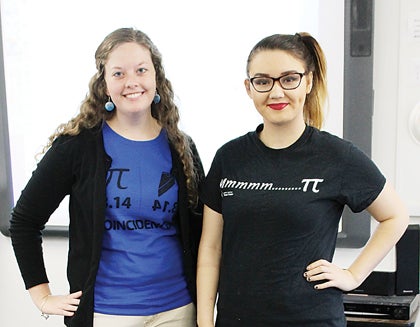Fight for your right to Pi Day
Published 8:16 am Tuesday, March 15, 2016

Contributed Photo
Unaka High School students Sarah Hoss and Josh Leavitt measure Little Debbie cakes to see if the diameter and circumference yield the ratio of pi.
3.1415926535897932384626433832795028841971693993751058…
The irrational number pi, represented by the Greek letter “π,” continues infinitely and is honored worldwide by students, teachers and math fanatics on March 14 (3-14).
“It’s a way for us to all to nerd out and eat pie,” said Dr. Mark Dula of Hampton High School.
Everyone celebrates differently, but the activity that no one seems to overlook is the sacred ingestion of pi(e).
Additionally, students worldwide recognize the ratio by discussing its significance, writing pi-ku poems, and converting things into pi, like time and age. For example, if a man is 44, he could say he is 14π.
Locally, students at Elizabethton, Hampton and Unaka High Schools, T.A. Dugger Junior High School and Little Milligan Elementary School ate pi(e) and learned about how π came into existence and how it is used.
Pi is the ratio of a circle’s circumference to its diameter. It is always the same for any circle, and its numerals never repeat. In 1873, British mathematician William Shanks calculated the numeral to 707 decimal places, according to a history of pi by University of Arkansas. In 2010, researcher Nicholas Sze calculated π to the two-quadrillionth digit, which took 23 days and 1,000 computers, according to a British Broadcasting Corporation report. Because of its infinite length, some students find it diverting to memorize it to the furthest decimal place possible.
Students in Mrs. Kip Anderson’s class at T.A. Dugger and in Mrs. Brooke Tolley’s class at Unaka High School calculated the circumference and diameter of Little Debbie pies. Anderson’s students also made bracelets with the decimal places of π and wrote raps and songs.

Contributed Photo
Jessica Buttars measures a pinwheel, then divides circumference by diameter to get pi.
Students in Mrs. Brooke Tolley’s Core Math II class also measured Little Debbie cakes to calculate pie.
Mrs. Lora Hooks’ geometry classes at EHS are celebrating Pi Week, with a handful of students bringing in homemade pies each day. In class, they measure the circumference and diameter of the pies in order to calculate the digits of π.
“They enjoy eating it, but it also gets them involved with their families because they can ask their grandmas or aunts to help with the project, and they get extra credit if someone videos or photographs them making their pie,” said Hooks.
Additionally, they each present a creative project which can be a graphic design, song, artwork, Powerpoint presentation or other creative display telling about π.
“I’ve had kids write a song and play it on piano and sing it,” Hooks recalled. “I’ve had kids make pane glass into mosaics — they get to choose, but everyone presents, so there is a public speaking element.”
At the end of the week, they judge each others’ pies and attempt to recite as many digits of π as possible of 500 decimal places that they have been memorizing. After about six years of celebrating Pi Week, it has become a tradition.
“Kids have heard about it and look forward to it when they take my class,” said Hooks.
Though it is a day full of puns and activities, teachers feel it is a day to recognize an important mathematical principal which serves a variety of purposes in fields like geometry, astronomy and trigonometry.
The numeral was first calculated most closely between 1900 and 1650 BCE on a Babylonian tablet, according to University of Arkansas. Archemedes of Syracuse (287-212 BCE) determined that pi equals 22/7, which is the ratio used today. Other mathematicians have calculated it differently, but mathematicians are safe to say approximately 3.14, or 22/7, equals π.
The Greek letter was first used in 1706 by William Jones, and it became popular in 1737 by the Swiss mathematician Leonhard Euler.
March 14 is also the cake day, or “pi” day for Albert Einstein and EHS math teacher Mr. Jeff Pierce’s birthdays.

Contributed Photo
Zoe Burrow made a pie with pi on top, which was in competition with a traditional and tediously lattaced cherry pie at Elizabethton High School.






